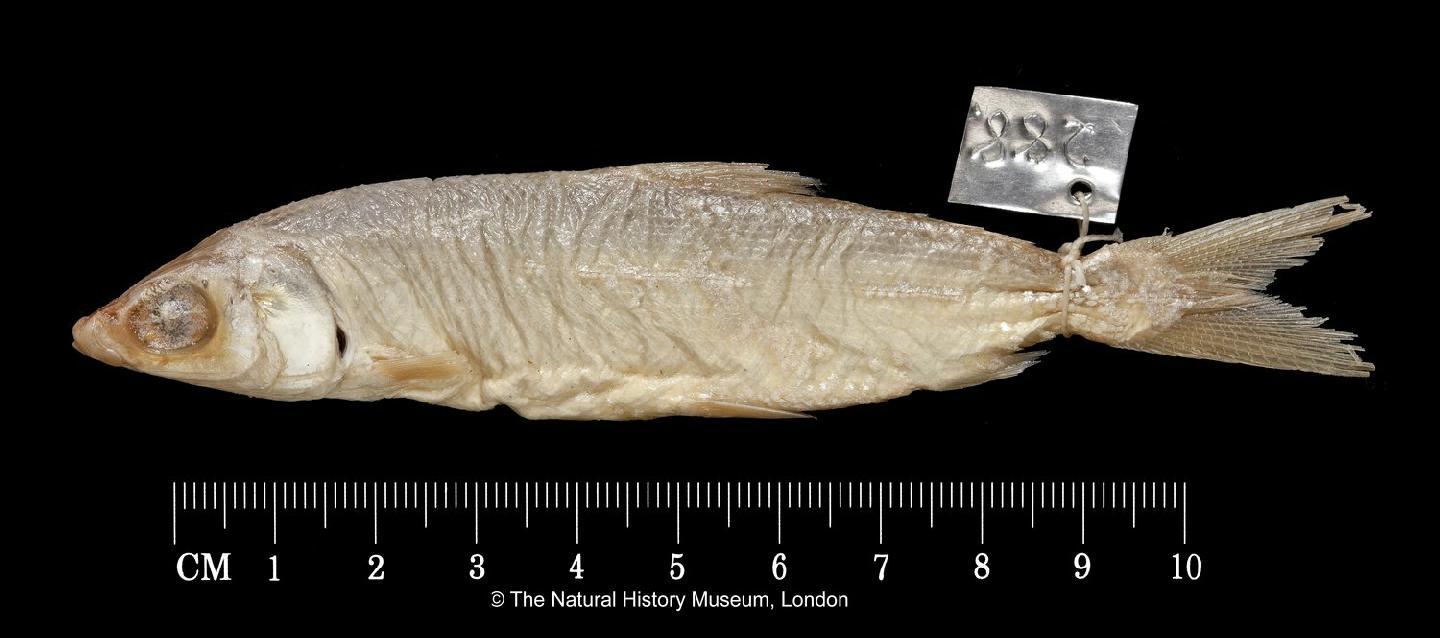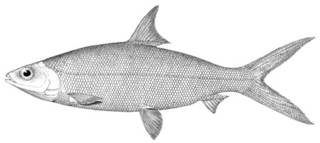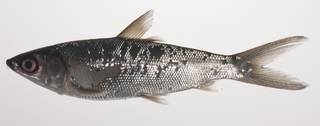
| Intro | | Search taxa | | Browse taxa | | Distributions | | Terminology | | References | | Statistics | | Online sources | | Tutorial | | Log in |
WoRMS taxon detailsChanos chanos (Fabricius, 1775)
217625 (urn:lsid:marinespecies.org:taxname:217625)
accepted
Species
Butirinus argenteus Jerdon, 1849 · unaccepted
Butirinus maderaspatensis Jerdon, 1849 · unaccepted (synonym)
Channo chanos (Fabricius, 1775) · unaccepted (misspelling)
Chanos arabicus Lacepède, 1803 · unaccepted
Chanos chloropterus Valenciennes, 1847 · unaccepted
Chanos cyprinella Valenciennes, 1847 · unaccepted
Chanos gardineri Regan, 1902 · unaccepted (synonym)
Chanos indicus (van Hasselt, 1823) · unaccepted
Chanos lubina Valenciennes, 1847 · unaccepted
Chanos mento Valenciennes, 1847 · unaccepted
Chanos mossambicus (Peters, 1852) · unaccepted
Chanos nuchalis Valenciennes, 1847 · unaccepted
Chanos orientalis Valenciennes, 1847 · unaccepted
Chanos salmoneus (Forster, 1801) · unaccepted
Chanos salmonoides (Forster, 1801) · unaccepted > misspelling - incorrect subsequent spelling
Chanos salmonoides Günther, 1879 · unaccepted > unavailable name (misspeling of the specific epithet)
Cyprinus pala Cuvier, 1829 · unaccepted (synonym)
Cyprinus palah Cuvier, 1829 · unaccepted
Cyprinus tolo Cuvier, 1829 · unaccepted (synonym)
Leuciscus palah (Cuvier, 1829) · unaccepted
Leuciscus salmoneus (Forster, 1801) · unaccepted
Leuciscus zeylonicus Bennett, 1833 · unaccepted (synonym)
Lutodeira chanos (Fabricius, 1775) · unaccepted
Lutodeira chloropterus (Valenciennes, 1847) · unaccepted
Lutodeira indica van Hasselt, 1823 · unaccepted
Lutodeira mossambica Peters, 1852 · unaccepted
Lutodeira mossambicus Peters, 1852 · unaccepted
Lutodeira salmonea (Forster, 1801) · unaccepted
Lutodira elongata Peters, 1859 · unaccepted (synonym)
Mugil chanos Fabricius, 1775 · unaccepted
Mugil salmoneus Forster, 1801 · unaccepted
Mugile chani Fabricius, 1775 · unaccepted > misspelling - incorrect subsequent spelling (misspelling of the original name)
marine, brackish, fresh,
(of Mugil chanos Fabricius, 1775) Forskål P. (1775). Descriptiones Animalium, Avium, Amphibiorum, Piscium, Insectorum, Vermium; quae in Itinere Orientali Observavit Petrus Forskål. Post Mortem Auctoris editit Carsten Niebuhr. Adjuncta est materia Medica Kahirina. Mölleri, Hafniae, 19 + xxxiv + 164 pp. , available online at https://www.biodiversitylibrary.org/page/2088059
page(s): 74, xiv [details]
Description Adults occur in small to large schools near the coasts or around islands where reefs are well developed. Eggs and larvae...
Description Adults occur in small to large schools near the coasts or around islands where reefs are well developed. Eggs and larvae are pelagic up to 2-3 weeks. Older larvae migrate onshore and settle in coastal wetlands (mangroves, estuaries) during the juvenile stage, or occasionally enter freshwater lakes. Juveniles and subadults return to sea where they mature sexually. Spawns only in fully saline water. Larvae eat zooplankton; juveniles and adults eat cyanobacteria, soft algae, small benthic invertebrates, and even pelagic fish eggs and larvae. Larvae are collected from rivers and are grown in culture ponds into juveniles, which are marketed fresh, smoked, canned and frozen. Broodstocks can be raised and spawned in captivity to produce larvae in the hatchery (Ref. 9815). Can thrive and grow in water as hot as 32° C (Ref. 9987). [details]
Froese, R. and D. Pauly. Editors. (2025). FishBase. Chanos chanos (Fabricius, 1775). Accessed through: World Register of Marine Species at: https://www.marinespecies.org/aphia.php?p=taxdetails&id=217625 on 2025-07-15
Date action by
Nomenclatureoriginal description
(of Mugil chanos Fabricius, 1775) Forskål P. (1775). Descriptiones Animalium, Avium, Amphibiorum, Piscium, Insectorum, Vermium; quae in Itinere Orientali Observavit Petrus Forskål. Post Mortem Auctoris editit Carsten Niebuhr. Adjuncta est materia Medica Kahirina. Mölleri, Hafniae, 19 + xxxiv + 164 pp. , available online at https://www.biodiversitylibrary.org/page/2088059 page(s): 74, xiv [details] original description (of Mugil salmoneus Forster, 1801) Bloch, M.E.; Schneider, J.G. (1801). M.E. Blochii, Systema Ichthyologiae iconibus cx illustratum. Post obitum auctoris opus inchoatum absolvit, correxit, interpolavit Jo. <em>Gottlob Schneider, Saxo. Berolini. Sumtibus Auctoris Impressum et Bibliopolio Sanderiano Commissum.</em> Pp i-lx + 1-584, Pls. 1-110., available online at https://www.biodiversitylibrary.org/bibliography/5750#/summary page(s): 121, xxxii [details] original description (of Cyprinus palah Cuvier, 1829) Cuvier, G. (1829). Le Règne Animal distribué, d'apres son organisation, pour servir de base à l'histoire naturelle des animaux et d'introduction à l'anatomie comparée. [The Animal Kingdom, arranged according to its organization, to serve as a basis for the natural history of animals and as an introduction to comparative anatomy]. <em>Déterville, Paris.</em> Edition 2. v. 2: i-xv + 1-406., available online at https://www.biodiversitylibrary.org/page/31771348 page(s): 276 [details] original description (of Chanos arabicus Lacepède, 1803) Lacepède, B.G.E. (1803). Histoire naturelle des poissons. Tome Cinquieme. 5(1-21): i-lxviii + 1-803 + index., available online at https://www.biodiversitylibrary.org/page/6335629 page(s): 395, 396 [details] original description (of Chanos chloropterus Valenciennes, 1847) Cuvier, G.; Valenciennes, A. (1847). Histoire naturelle des poissons. Tome dix-neuvième. Suite du livre dix-neuvième. Brochets ou Lucioïdes. Livre vingtième. De quelques familles de Malacoptérygiens, intermédiaires entre les Brochets et les Clupes. 19: i-xix + 1-544 + 6 pp. Pls. 554-590. [details] original description (of Chanos cyprinella Valenciennes, 1847) Cuvier, G.; Valenciennes, A. (1847). Histoire naturelle des poissons. Tome dix-neuvième. Suite du livre dix-neuvième. Brochets ou Lucioïdes. Livre vingtième. De quelques familles de Malacoptérygiens, intermédiaires entre les Brochets et les Clupes. 19: i-xix + 1-544 + 6 pp. Pls. 554-590. [details] original description (of Chanos lubina Valenciennes, 1847) Cuvier, G.; Valenciennes, A. (1847). Histoire naturelle des poissons. Tome dix-neuvième. Suite du livre dix-neuvième. Brochets ou Lucioïdes. Livre vingtième. De quelques familles de Malacoptérygiens, intermédiaires entre les Brochets et les Clupes. 19: i-xix + 1-544 + 6 pp. Pls. 554-590. [details] original description (of Chanos mento Valenciennes, 1847) Cuvier, G.; Valenciennes, A. (1847). Histoire naturelle des poissons. Tome dix-neuvième. Suite du livre dix-neuvième. Brochets ou Lucioïdes. Livre vingtième. De quelques familles de Malacoptérygiens, intermédiaires entre les Brochets et les Clupes. 19: i-xix + 1-544 + 6 pp. Pls. 554-590. [details] original description (of Chanos orientalis Valenciennes, 1847) Cuvier, G.; Valenciennes, A. (1847). Histoire naturelle des poissons. Tome dix-neuvième. Suite du livre dix-neuvième. Brochets ou Lucioïdes. Livre vingtième. De quelques familles de Malacoptérygiens, intermédiaires entre les Brochets et les Clupes. 19: i-xix + 1-544 + 6 pp. Pls. 554-590. [details] original description (of Butirinus argenteus Jerdon, 1849) Jerdon, T. C. (1849). On the fresh-water fishes of southern India. (Continued from p. 149.). <em>Madras Journal of Literature and Science.</em> v. 15 (pt 2): 302-346. [details] original description (of Lutodeira indica van Hasselt, 1823) van Hasselt, J. C. (1823). Uittreksel uit een' brief van Dr. J. C. van Hasselt, aan den Heer C. J. Temminck. <em>Algemeene Konst- en Letter-bode voor het Jaar I.</em> Deel (no. 21): 329-33. [details] original description (of Chanos nuchalis Valenciennes, 1847) Cuvier, G.; Valenciennes, A. (1847). Histoire naturelle des poissons. Tome dix-neuvième. Suite du livre dix-neuvième. Brochets ou Lucioïdes. Livre vingtième. De quelques familles de Malacoptérygiens, intermédiaires entre les Brochets et les Clupes. 19: i-xix + 1-544 + 6 pp. Pls. 554-590. [details] original description (of Cyprinus pala Cuvier, 1829) Cuvier, G. (1829). Le Règne Animal distribué, d'apres son organisation, pour servir de base à l'histoire naturelle des animaux et d'introduction à l'anatomie comparée. [The Animal Kingdom, arranged according to its organization, to serve as a basis for the natural history of animals and as an introduction to comparative anatomy]. <em>Déterville, Paris.</em> Edition 2. v. 2: i-xv + 1-406., available online at https://www.biodiversitylibrary.org/page/31771348 page(s): 276 [details] original description (of Butirinus maderaspatensis Jerdon, 1849) Jerdon, T. C. (1849). On the fresh-water fishes of southern India. (Continued from p. 149.). <em>Madras Journal of Literature and Science.</em> v. 15 (pt 2): 302-346. [details] original description (of Leuciscus zeylonicus Bennett, 1833) Bennett, E. T. (1833). Characters of new species of fishes from Ceylon. <em>Proceedings of the Committee of Science and Correspondence of the Zoological Society of London.</em> 1832 (pt 2): 182-184. [details] original description (of Cyprinus tolo Cuvier, 1829) Cuvier, G. (1829). Le Règne Animal distribué, d'apres son organisation, pour servir de base à l'histoire naturelle des animaux et d'introduction à l'anatomie comparée. [The Animal Kingdom, arranged according to its organization, to serve as a basis for the natural history of animals and as an introduction to comparative anatomy]. <em>Déterville, Paris.</em> Edition 2. v. 2: i-xv + 1-406., available online at https://www.biodiversitylibrary.org/page/31771348 page(s): 276 [details] basis of record Froese, R. & D. Pauly (Editors). (2025). FishBase. World Wide Web electronic publication. version (06/2024)., available online at https://www.fishbase.org [details] Ecologyecology source
Looby, A.; Erbe, C.; Bravo, S.; Cox, K.; Davies, H. L.; Di Iorio, L.; Jézéquel, Y.; Juanes, F.; Martin, C. W.; Mooney, T. A.; Radford, C.; Reynolds, L. K.; Rice, A. N.; Riera, A.; Rountree, R.; Spriel, B.; Stanley, J.; Vela, S.; Parsons, M. J. G. (2023). Global inventory of species categorized by known underwater sonifery. <em>Scientific Data.</em> 10(1). (look up in IMIS), available online at https://doi.org/10.1038/s41597-023-02745-4 [details] Othercontext source (Introduced species)
Katsanevakis, S.; Bogucarskis, K.; Gatto, F.; Vandekerkhove, J.; Deriu, I.; Cardoso A.S. (2012). Building the European Alien Species Information Network (EASIN): a novel approach for the exploration of distributed alien species data. <em>BioInvasions Records.</em> 1: 235-245., available online at http://easin.jrc.ec.europa.eu [details] Available for editors
context source (HKRMS) Hong Kong marine fish database. <em>AFCD.</em> , available online at https://www.hk-fish.net/en/fish/introduction/ [details] context source (RAS) Australian Antarctic Data Centre. , available online at https://data.aad.gov.au/aadc/biodiversity/ [details] context source (PeRMS) Chirichigno, N.; Cornejo, M. (2001). Catálogo comentado de los peces marinos del Perú. <em>2ª ed. Instituto del Mar de Perú. Publicación Especial. Callao.</em> 314 p. [details] additional source Liu, J.Y. [Ruiyu] (ed.). (2008). Checklist of marine biota of China seas. <em>China Science Press.</em> 1267 pp. (look up in IMIS) [details] Available for editors additional source Zenetos, A., Gofas, S., Morri, C., Rosso, A, Violanti, D., Garcia Raso, J. E., Cinar, M. E., Almogi-Labin, A., Ates, A. S., Azzurro, E., Ballesteros, E., Bianchi, C. N., Bilecenoglu, M., Gambi, M. C., Giangrande, A., Gravili, C., Hyams-Kaphzan, O., Karachle, P. K., Katsanevakis, S., Lipej, L., Mastrototaro, F., Mineur, F., Pancucci-Papadopoulou, M. A., Ramos Espla, A., Salas, C., San Martin, G., Sfriso, A., Streftaris, N., and Verlaque, M. (2012). Alien species in the Mediterranean Sea by 2012. A contribution to the application of European Union's Marine Strategy Framework Directive (MSFD). Part 2. Introduction trends and pathways. <em>Mediterranean Marine Science.</em> 13(2): 328-352. [details] Available for editors  Present Present  Present in aphia/obis/gbif/idigbio Present in aphia/obis/gbif/idigbio  Inaccurate Inaccurate  Introduced: alien Introduced: alien  Containing type locality Containing type locality
From regional or thematic species database
Introduced species vector dispersal in Turkish part of the Mediterranean Sea - Eastern Basi (Marine Region) : Fisheries: deliberate translocations of fish or shellfish to establish or support fishery [details]Unreviewed
Description Adults occur in small to large schools near the coasts or around islands where reefs are well developed. Eggs and larvae are pelagic up to 2-3 weeks. Older larvae migrate onshore and settle in coastal wetlands (mangroves, estuaries) during the juvenile stage, or occasionally enter freshwater lakes. Juveniles and subadults return to sea where they mature sexually. Spawns only in fully saline water. Larvae eat zooplankton; juveniles and adults eat cyanobacteria, soft algae, small benthic invertebrates, and even pelagic fish eggs and larvae. Larvae are collected from rivers and are grown in culture ponds into juveniles, which are marketed fresh, smoked, canned and frozen. Broodstocks can be raised and spawned in captivity to produce larvae in the hatchery (Ref. 9815). Can thrive and grow in water as hot as 32° C (Ref. 9987). [details]
To Barcode of Life (217 barcodes)
To Biodiversity Heritage Library (1 publication) (from synonym Chanos salmonoides Günther, 1879) To Biodiversity Heritage Library (10 publications) (from synonym Chanos chloropterus Valenciennes, 1847) To Biodiversity Heritage Library (11 publications) (from synonym Chanos cyprinella Valenciennes, 1847) To Biodiversity Heritage Library (11 publications) (from synonym Chanos nuchalis Valenciennes, 1847) To Biodiversity Heritage Library (12 publications) (from synonym Lutodeira salmonea (Forster, 1801)) To Biodiversity Heritage Library (142 publications) To Biodiversity Heritage Library (15 publications) (from synonym Chanos mento Valenciennes, 1847) To Biodiversity Heritage Library (19 publications) (from synonym Chanos lubina Valenciennes, 1847) To Biodiversity Heritage Library (19 publications) (from synonym Chanos orientalis Valenciennes, 1847) To Biodiversity Heritage Library (2 publications) (from synonym Lutodeira chloropterus (Valenciennes, 1847)) To Biodiversity Heritage Library (2 publications) (from synonym Leuciscus salmoneus (Forster, 1801)) To Biodiversity Heritage Library (23 publications) (from synonym Chanos arabicus Lacepède, 1803) To Biodiversity Heritage Library (3 publications) (from synonym Mugile chani Fabricius, 1775) To Biodiversity Heritage Library (3 publications) (from synonym Chanos mossambicus (Peters, 1852)) To Biodiversity Heritage Library (34 publications) (from synonym Mugil salmoneus Forster, 1801) To Biodiversity Heritage Library (39 publications) (from synonym Mugil chanos Fabricius, 1775) To Biodiversity Heritage Library (4 publications) (from synonym Butirinus argenteus Jerdon, 1849) To Biodiversity Heritage Library (46 publications) (from synonym Lutodeira chanos (Fabricius, 1775)) To Biodiversity Heritage Library (6 publications) (from synonym Chanos indicus (van Hasselt, 1823)) To Biodiversity Heritage Library (9 publications) (from synonym Lutodeira indica van Hasselt, 1823) To Biodiversity Heritage Library (92 publications) (from synonym Chanos salmoneus (Forster, 1801)) To Biological Information System for Marine Life (BISMaL) To European Nucleotide Archive, ENA (Chanos chanos) To FAO Cultured Aquatic species fact sheets To FishBase To FishBase (from synonym Cyprinus palah Cuvier, 1829) To FishBase (from synonym Leuciscus palah (Cuvier, 1829)) To FishBase (from synonym Leuciscus salmoneus (Forster, 1801)) To FishBase (from synonym Chanos lubina Valenciennes, 1847) To FishBase (from synonym Chanos indicus (van Hasselt, 1823)) To FishBase (from synonym Chanos mento Valenciennes, 1847) To FishBase (from synonym Chanos mossambicus (Peters, 1852)) To FishBase (from synonym Chanos chloropterus Valenciennes, 1847) To FishBase (from synonym Chanos cyprinella Valenciennes, 1847) To FishBase (from synonym Chanos arabicus Lacepède, 1803) To FishBase (from synonym Mugil chanos Fabricius, 1775) To FishBase (from synonym Mugil salmoneus Forster, 1801) To FishBase (from synonym Chanos salmoneus (Forster, 1801)) To FishBase (from synonym Chanos nuchalis Valenciennes, 1847) To FishBase (from synonym Chanos orientalis Valenciennes, 1847) To FishBase (from synonym Lutodeira chloropterus (Valenciennes, 1847)) To FishBase (from synonym Lutodeira chanos (Fabricius, 1775)) To FishBase (from synonym Butirinus argenteus Jerdon, 1849) To FishBase (from synonym Chanos salmonoides Günther, 1879) To Fishbase (from synonym Lutodeira mossambicus Peters, 1852) To FishBase (from synonym Lutodeira salmonea (Forster, 1801)) To FishBase (from synonym Lutodeira indica van Hasselt, 1823) To FishBase (from synonym Mugile chani Fabricius, 1775) To FishBase (from synonym Cyprinus tolo Cuvier, 1829) To Fishbase (from synonym Lutodira elongata Peters, 1859) To FishBase (from synonym Channo chanos (Fabricius, 1775)) To FishBase (from synonym Lutodeira mossambica Peters, 1852) To FishBase (from synonym Cyprinus pala Cuvier, 1829) To FishBase (from synonym Chanos gardineri Regan, 1902) To FishBase (from synonym Butirinus maderaspatensis Jerdon, 1849) To FishBase (from synonym Leuciscus zeylonicus Bennett, 1833) To FishBase images (Chanos chanos, Sudan, by Randall, J.E.) To GenBank (37776 nucleotides; 32075 proteins) To GenBank (37776 nucleotides; 32075 proteins) (from synonym Mugil chanos Fabricius, 1775) To Global Biotic Interactions (GloBI) To IUCN Red List (Least Concern) To NHMUK collection (Leuciscus zeylonicus Bennett, 1833; HOLOTYPE; NHMUK:ecatalogue:2650992) (from synonym Leuciscus zeylonicus Bennett, 1833) To NMNH Extant Collection (Chanos chanos P02240 illustration) (from synonym Chanos salmoneus (Forster, 1801)) To NMNH Extant Collection (Chanos chanos RAD101948-001) (from synonym Chanos salmoneus (Forster, 1801)) To NMNH Extant Collection (Chanos chanos USNM 403160 photograph lateral view) To NMNH Extant Collection (Chanos chanos USNM 435471 photograph lateral view) To ITIS |






